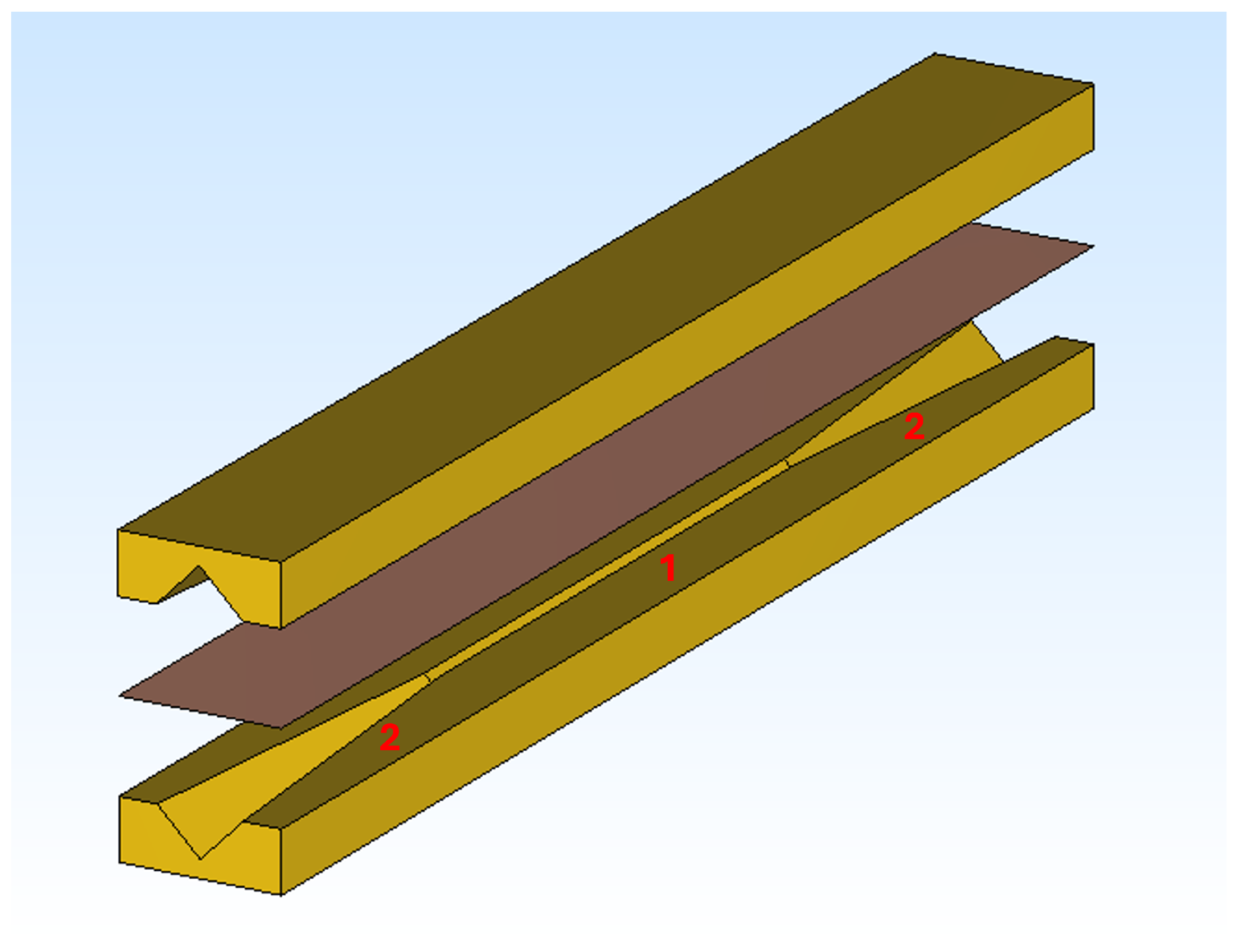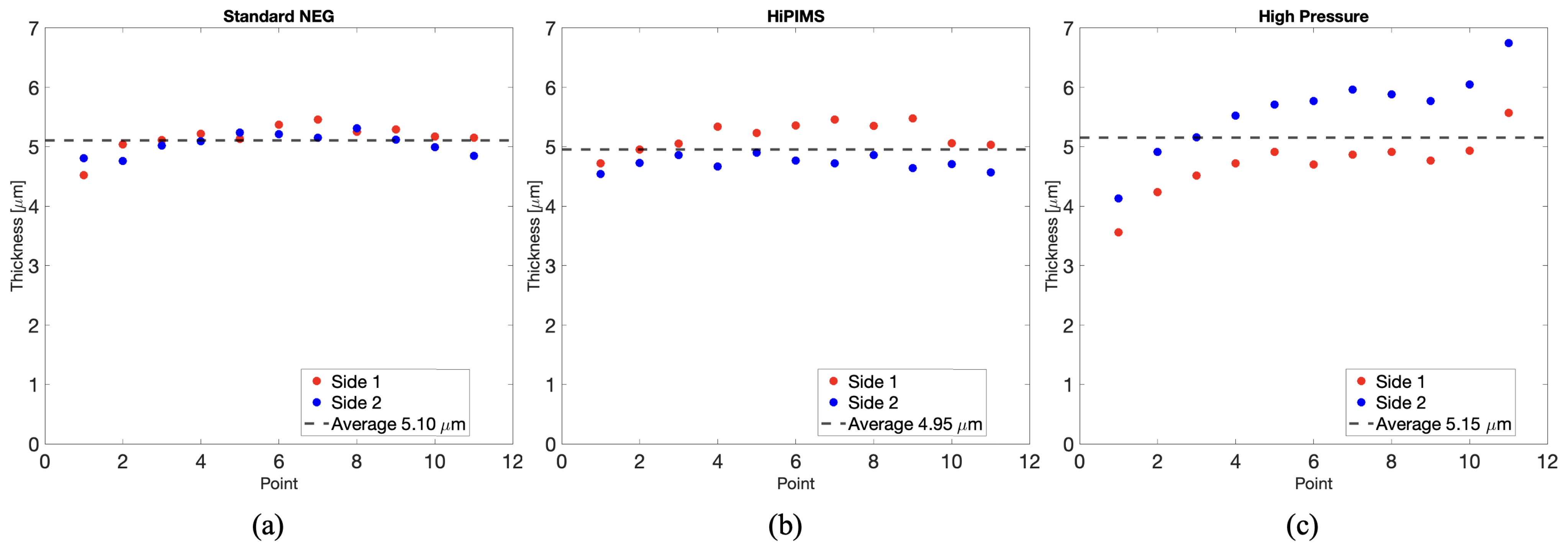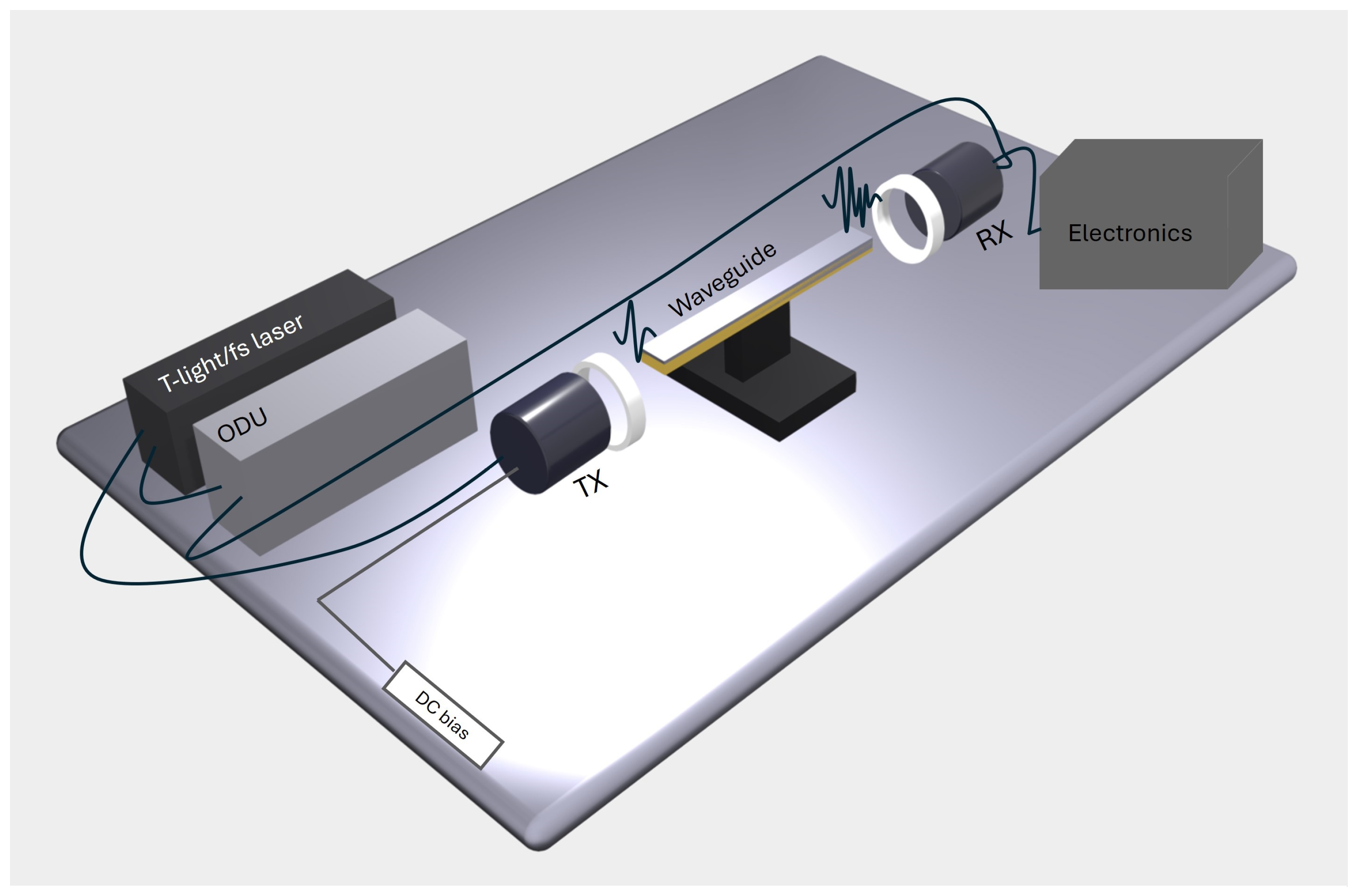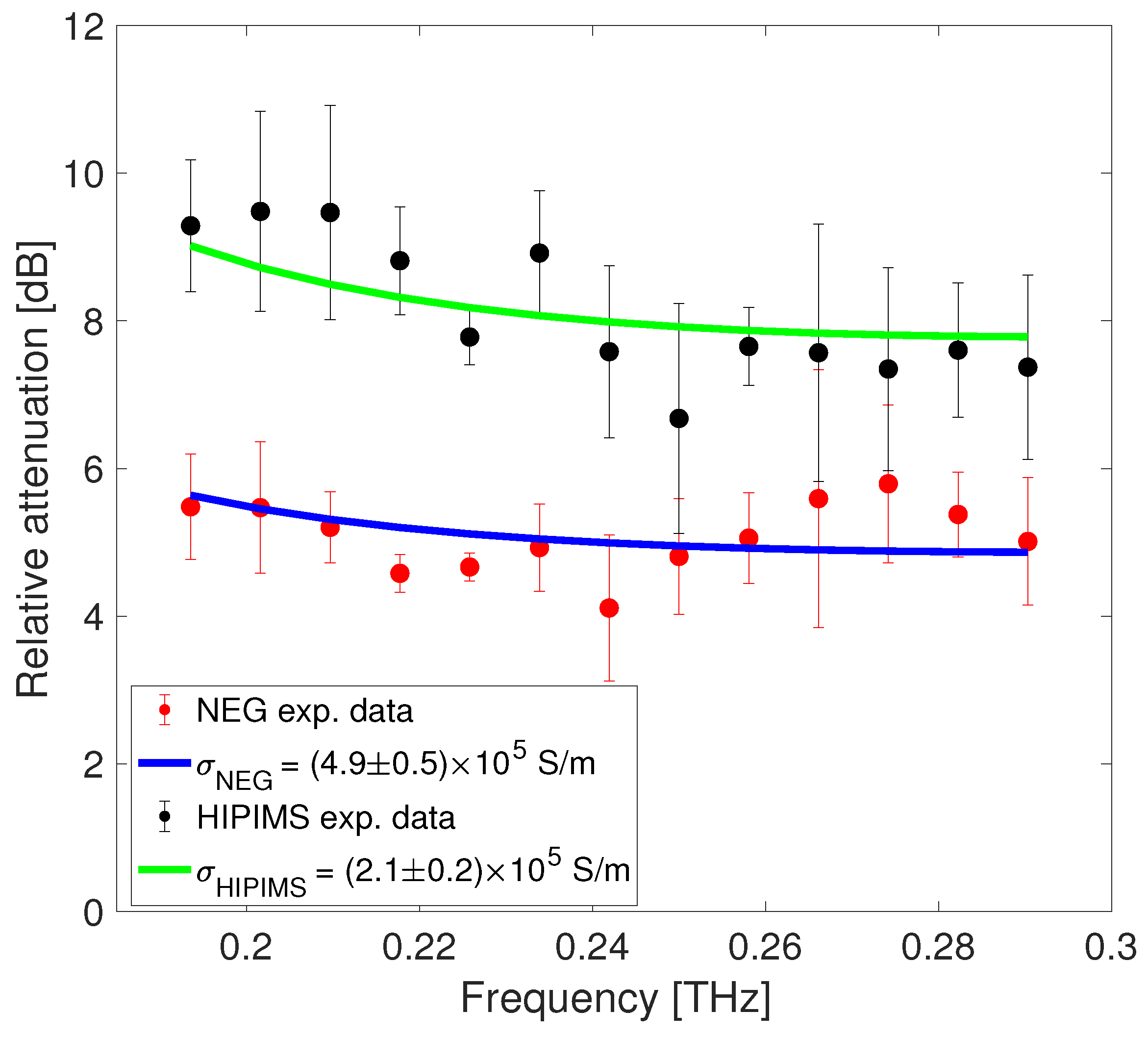Sub-THz Characterization of Technical Surfaces for Particle Accelerator Vacuum Chambers
Abstract
:1. Introduction
2. Materials and Methods
2.1. The Methodology
2.2. Electromagnetic Characterization
3. Results and Discussion
4. Conclusions
Author Contributions
Funding
Institutional Review Board Statement
Informed Consent Statement
Data Availability Statement
Acknowledgments
Conflicts of Interest
References
- Cimino, R.; Demma, T. Electron cloud in accelerators. Int. J. Mod. Phys. A 2014, 29, 1430023. [Google Scholar] [CrossRef]
- Benvenuti, C.; Chiggiato, P.; Pinto, P.C.; Santana, A.E.; Hedley, T.; Mongelluzzo, A.; Ruzinov, V.; Wevers, I. Vacuum properties of TiZrV non-evaporable getter films. Vacuum 2001, 60, 57–65. [Google Scholar] [CrossRef]
- Palumbo, L.; Vaccaro, V.G.; Zobov, M. Wake fields and impedance. In Proceedings of the CERN Accelerator School: Course on Advanced Accelerator Physics (CAS), Rhodes, Greece, 20 September–1 October 1993. [Google Scholar] [CrossRef]
- Chao, A.W. Physics of Collective Beam Instabilities in High-Energy Accelerators; Wiley-Interscience: New York, NY, USA, 1993. [Google Scholar]
- Ng, K.Y. Physics of Intensity Dependent Beam Instabilities; World Scientific: Singapore, 2005. [Google Scholar] [CrossRef]
- Migliorati, M.; Belli, E.; Zobov, M. Impact of the resistive wall impedance on beam dynamics in the Future Circular e+e- Collider. Phys. Rev. Accel. Beams 2018, 21, 041001. [Google Scholar] [CrossRef]
- Metral, E.; Rumolo, G.; Herr, W. Impedance and Collective Effects. In Particle Physics Reference Library: Volume 3: Accelerators and Colliders; Myers, S., Schopper, H., Eds.; Springer International Publishing: Cham, Switzerland, 2020; pp. 105–181. [Google Scholar] [CrossRef]
- Malyshev, O.B.; Gurran, L.; Goudket, P.; Marinov, K.; Wilde, S.; Valizadeh, R.; Burt, G. RF surface resistance study of non-evaporable getter coatings. Nucl. Instrum. Methods Phys. Res. Sect. A Accel. Spectrometers Detect. Assoc. Equip. 2017, 844, 99–107. [Google Scholar] [CrossRef]
- Dehler, M.; Alberti, S.; Citterio, A.; Hahn, M.; Hogge, J.P.; Liu, X.; Marques, H. Characterization of NEG Coatings for SLS 2.0. In Proceedings of the 10th International Particle Accelerator Conference, Melbourne, Australia, 19–24 May 2019; p. TUPGW108. [Google Scholar] [CrossRef]
- Koukovini-Platia, E.; Rumolo, G.; Zannini, C. Electromagnetic characterization of nonevaporable getter properties between 220–330 and 500–750 GHz for the Compact Linear Collider damping rings. Phys. Rev. Accel. Beams 2017, 20, 011002. [Google Scholar] [CrossRef]
- Koukovini Platia, E. High Frequency Effects of Impedances and Coatings in the CLIC Damping Rings. Ph.D. Thesis, Ecole Polytechnique, Lausanne, Switzerland, 2015. [Google Scholar]
- Theuer, M.; Melinger, J.S. High Resolution Waveguide Terahertz Time-Domain Spectroscopy. J. Infrared Millim. Terahertz Waves 2011, 32, 1267–1284. [Google Scholar] [CrossRef]
- Razanoelina, M.; Kinjo, R.; Takayama, K.; Kawayama, I.; Murakami, H.; Mittleman, D.M.; Tonouchi, M. Parallel-Plate Waveguide Terahertz Time Domain Spectroscopy for Ultrathin Conductive Films. J. Infrared Millim. Terahertz Waves 2015, 36, 1182–1194. [Google Scholar] [CrossRef]
- Khachatrian, A.; Melinger, J.S.; Qadri, S.B. Waveguide terahertz time-domain spectroscopy of ammonium nitrate polycrystalline films. J. Appl. Phys. 2012, 111, 093103. [Google Scholar] [CrossRef]
- Gallot, G.; Jamison, S.P.; McGowan, R.W.; Grischkowsky, D. Terahertz waveguides. J. Opt. Soc. Am. B 2000, 17, 851–863. [Google Scholar] [CrossRef]
- Zhang, J.; Grischkowsky, D. Adiabatic compression of parallel-plate metal waveguides for sensitivity enhancement of waveguide THz time-domain spectroscopy. Appl. Phys. Lett. 2005, 86, 061109. [Google Scholar] [CrossRef]
- Passarelli, A.; Bartosik, H.; Rumolo, G.; Vaccaro, V.G.; Masullo, M.R.; Koral, C.; Papari, G.P.; Andreone, A.; Boine-Frankenheim, O. Novel measurement technique for the electromagnetic characterization of coating materials in the sub-THz frequency range. Phys. Rev. Accel. Beams 2018, 21, 103101. [Google Scholar] [CrossRef]
- Gamelin, A.; Foosang, W. Influence of the coating resistivity on beam dynamics. Phys. Rev. Accel. Beams 2023, 26, 054401. [Google Scholar] [CrossRef]
- Passarelli, A.; Koral, C.; Masullo, M.R.; Vollenberg, W.; Amador, L.L.; Andreone, A. Sub-THz Waveguide Spectroscopy of Coating Materials for Particle Accelerators. Condens. Matter 2020, 5, 9. [Google Scholar] [CrossRef]
- Karantzoulis, E.; Di Mitri, S.; Barbo, F.; Barletta, W.; Bassanese, S.; Bracco, R.; Brajnik, G.; Buonanno, A.; Caiazza, D.; Carniel, A.; et al. Design strategies and technology of Elettra 2.0 for a versatile offer to the user community. Nucl. Instrum. Methods Phys. Res. Sect. A Accel. Spectrometers Detect. Assoc. Equip. 2024, 1060, 169007. [Google Scholar] [CrossRef]
- Marcuvitz, N. Waveguide Handbook; IEE Electromag. Waves, Peregrinus: London, UK, 1986. [Google Scholar]
- Franceschetti, G. Electromagnetics: Theory, Techniques, and Engineering Paradigms; Springer Science & Business Media: New York, NY, USA, 1997. [Google Scholar]
- Yin Vallgren, C.; Arduini, G.; Bauche, J.; Calatroni, S.; Chiggiato, P.; Cornelis, K.; Pinto, P.C.; Henrist, B.; Métral, E.; Neupert, H.; et al. Amorphous carbon coatings for the mitigation of electron cloud in the CERN Super Proton Synchrotron. Phys. Rev. ST Accel. Beams 2011, 14, 071001. [Google Scholar] [CrossRef]
- Lee, C.S.; Lee, S.W.; Chuang, S.L. Plot of Modal Field Distribution in Rectangular and Circular Waveguides. IEEE Trans. Microw. Theory Tech. 1985, 33, 271–274. [Google Scholar] [CrossRef]
- Passarelli, A.; Andreone, A.; Vaccaro, V.G.; Masullo, M.R.; Papaphilippou, Y.; Corsini, R. Time Domain Measurements of The Sub-Thz Response of Different Coatings for Beam Pipe Walls. In Proceedings of the ICFA mini-Workshop on Mitigation of Coherent Beam Instabilities in Particle Accelerators, Zermatt, Switzerland, 23–27 September 2019; CERN Yellow Reports: Conference Proceedings 2020. Volume 9. [Google Scholar]
- Mendis, R.; Mittleman, D.M. An investigation of the lowest-order transverse-electric (TE1) mode of the parallel-plate waveguide for THz pulse propagation. J. Opt. Soc. Am. B 2009, 26, A6–A13. [Google Scholar] [CrossRef]
- Hammerstad, E.; Jensen, O. Accurate Models for Microstrip Computer-Aided Design. In Proceedings of the 1980 IEEE MTT-S International Microwave symposium Digest, Washington, DC, USA, 28–30 May 1980; pp. 407–409. [Google Scholar] [CrossRef]
- Prodromides, A.E.; Levy, F. Non-Evaporable Getter Thin Film Coatings for Vacuum Applications. Ph.D. Thesis, Ecole Polytechnique, Lausanne, Switzerland, 2002; pp. 95–96. [Google Scholar]
- Mendis, R.; Grischkowsky, D. Undistorted guided-wave propagation of subpicosecond terahertz pulses. Opt. Lett. 2001, 26, 846–848. [Google Scholar] [CrossRef] [PubMed]
- Wang, S.; Zhu, B.; Gao, Y.; Shu, X.; Wei, W.; Zhang, W.; Wang, Y. On the synergy manipulation between the activation temperature, surface resistance and secondary electron yield of NEG thin films. Appl. Surf. Sci. 2022, 578, 152101. [Google Scholar] [CrossRef]









| Waveguide material | Brass (Au plated) |
| Guiding structure | Diagonal |
| Length [mm] | 62 |
| Side [mm] | |
| Transition | Pyramidal Horns |
| Length [mm] | 39 |
| Side (min and max apertures [mm] | |
| Total length [mm] | 140 |
| Sample | Slab |
| Material | Copper (+NEG) |
| Length [mm] | 140 |
| Thickness [m] | 50 (+coating) |
| Coating | Thickness [m] | [S/m] | Method and Frequency | Reference |
|---|---|---|---|---|
| Columnar NEG | 0.93–24.5 | RF cavity ( GHz) | [8] | |
| Dense NEG | 0.76–14.5 | RF cavity ( GHz) | [8] | |
| TiZrV NEG | Four-probe technique (DC) | [30] | ||
| TiZrV-Cu NEG | Four-probe technique (DC) | [30] | ||
| TiZrV NEG | 3 non-homogeneous | WG in FD (500–750 GHz) | [10] | |
| TiZrV NEG | 3 non-homogeneous | WG in FD (220–340 GHz) | [10] | |
| TiZrV NEG | 9 | WG in FD (10 GHz) | [10] | |
| TiZrV NEG | 3.8 | WG in TD (190–300 GHz) | [19] | |
| TiZrV NEG | 4.3 | WG in TD (190–300 GHz) | [19] | |
| TiZrV NEG | 5.1 | WG in TD (190–300 GHz) | This work | |
| HiPIMS NEG | 4.95 | WG in TD (190–300 GHz) | This work |
Disclaimer/Publisher’s Note: The statements, opinions and data contained in all publications are solely those of the individual author(s) and contributor(s) and not of MDPI and/or the editor(s). MDPI and/or the editor(s) disclaim responsibility for any injury to people or property resulting from any ideas, methods, instructions or products referred to in the content. |
© 2024 by the authors. Licensee MDPI, Basel, Switzerland. This article is an open access article distributed under the terms and conditions of the Creative Commons Attribution (CC BY) license (https://creativecommons.org/licenses/by/4.0/).
Share and Cite
Passarelli, A.; Masullo, M.R.; Mazaheri, Z.; Andreone, A. Sub-THz Characterization of Technical Surfaces for Particle Accelerator Vacuum Chambers. Sensors 2024, 24, 5036. https://doi.org/10.3390/s24155036
Passarelli A, Masullo MR, Mazaheri Z, Andreone A. Sub-THz Characterization of Technical Surfaces for Particle Accelerator Vacuum Chambers. Sensors. 2024; 24(15):5036. https://doi.org/10.3390/s24155036
Chicago/Turabian StylePassarelli, Andrea, Maria Rosaria Masullo, Zahra Mazaheri, and Antonello Andreone. 2024. "Sub-THz Characterization of Technical Surfaces for Particle Accelerator Vacuum Chambers" Sensors 24, no. 15: 5036. https://doi.org/10.3390/s24155036





